
www.melaniebahuon.com

Objectif Vendée Globe 2024

Dériveur école - double et solo

Nouvelle série de catamarans M2

NTFM-SYRA 18

Vol à haute vitesse!
Ino-padeye by VMG

DAME DESIGN AWARD - mention spéciale

VMG 40'

La grande croisière en kit
L'aérotech

Déflecteur aéro améliorant l'écoulement sur le foc
Sur la table à dessin

Catamaran de raid
Accastillage VMG

Nouvelles gammes 2023 pour répondre au mieux aux retours des utilisateurs
Shop en ligne:.
VMG Yacht Design, Lausanne, Vaud, Suisse, Switzerland
Practical Boat Owner
- Digital edition

The VMG 40 – a 40ft kit boat for bluewater cruising
- Katy Stickland
- June 23, 2023
VMG Yacht Design's VMG 40 can be built from a modular kit and is aimed at the offshore cruising market

he wide beam provides plenty of accommodation. Credit: VMG Yacht Design Credit: VMG Yacht Design
First look at the VMG 40
The Swiss firm VMG Yacht Design has just unveiled its plans for a 40ft cruising boat, which can be built from a modular kit out of plywood, epoxy, fibreglass or linen.
The design has been inspired by modern offshore racing yachts with wide beams, which provides plenty of accommodation below.
There are two layout options, although both offer a large master cabin in the forepeak, with two double cabins aft.

One of the two layout options available for the VMG 40. Credit: VMG Yacht Design
The galley can be L-shaped if desired.
There is a heads with shower, chart table and saloon to accommodate up to eight people.
Continues below…

First look at the BayCruiser 32
Swallow Yachts is now expanding its BayCruiser range with the BayCruiser 32

Bente 28: designed for sailing offshore
The new Bente 28 builds from the success of the Bente 24, and has been designed for cruising further afield
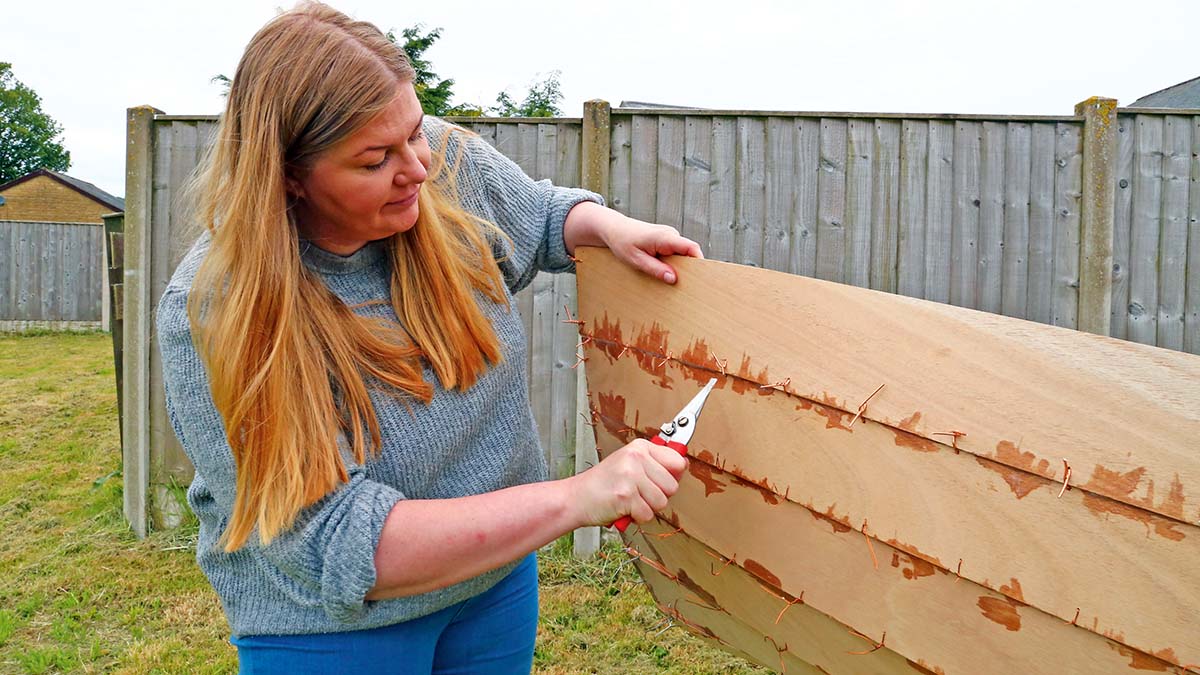
How to build a boat: Essential guide to building your first kit boat
The question of how to build a boat can be met with a dizzying array of answers. A website search…
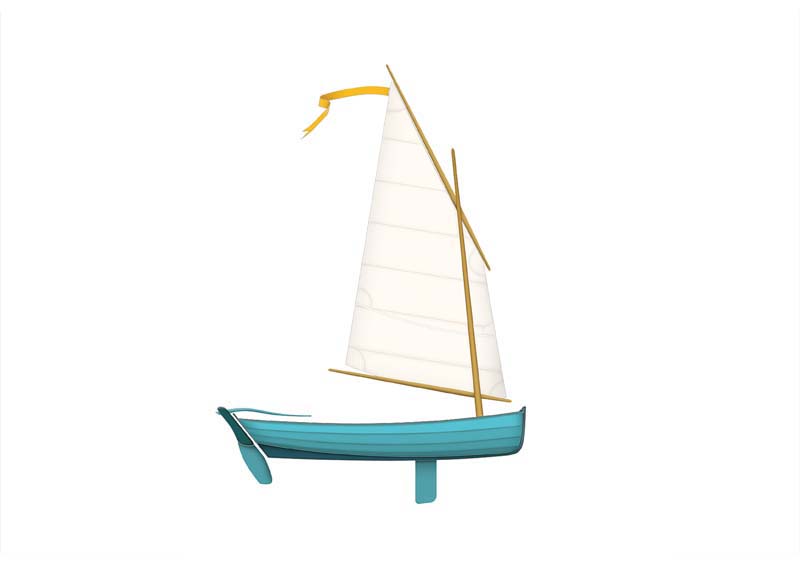
Free boat plans – Build your own Nigel Irens 14ft rowing and sailing skiff
Fancy building your own Nigel Irens-designed 14ft rowing/sailing skiff? Nic Compton explains how to get the plans for free
Panoramic windows mean the main living area is bright.
The sail area is 85.7m2/922ft2, and the keel is available in two different draughts.
All the lines are led aft to the spacious cockpit, which has plenty of lazarette space for storage.

Aft, there is a swim platform. Credit: VMG Yacht Design
The VMG 40 is designed for a 30-50CV engine , with a 170lt fuel tank, 340lt fresh water tank, 60lt black water tank and 88lt grey water tank.
As well as the construction manual and the plans and technical documents, the VMG 40 kit includes pre-cut Okoumé CTBX for the hull, the structure, the deck and the cockpit with cut-outs for fixed glazing as well as lining frames and cut-outs for fixed and opening glazing.

The second layout option on the VMG 40. Credit: VMG Yacht Design
A keel pack with spare parts, rudder and steering system pack with spare parts and a rigging pack with the mast boom and standing rigging also comes with the full kit.
Pre-made kit for the interior furniture and a ready to assemble ironwork kit which includes chainplates, pulpits and stanchions are also available as options.
VMG 40 specifications
LOA: 11.95m/39ft 3in LWL: 11.00m/36ft 1n Beam: 4.30m/14ft 2in Draught: 1.7m/2.2m – 5ft 6in/7ft 3in Sail Area: 85.7 sq m/922.46sq ft Displacement: 6,000kg/13,227lbs Engine: 30-50CV Fresh water: 350 lt/76.96 gal Fuel: 170 lt/37.3 gal Black water: 60 lt/13.1 gal Grey water: 88 lt/19.35 gal Materials: Plywood, glass fibre or linen, epoxy Price: From €17,000/ £14,535 for the plans, technical documents and construction manual Contact: vmgyachtdesign.com
Enjoyed reading this article?
A subscription to Practical Boat Owner magazine costs around 40% less than the cover price .
Print and digital editions are available through Magazines Direct – where you can also find the latest deals .
PBO is packed with information to help you get the most from boat ownership – whether sail or power.
- Take your DIY skills to the next level with trusted advice on boat maintenance and repairs
- Impartial in-depth gear reviews
- Practical cruising tips for making the most of your time afloat
Follow us on Facebook , Instagram and Twitter

Olivier van Meer 73ft ‘Spirit of Venice’
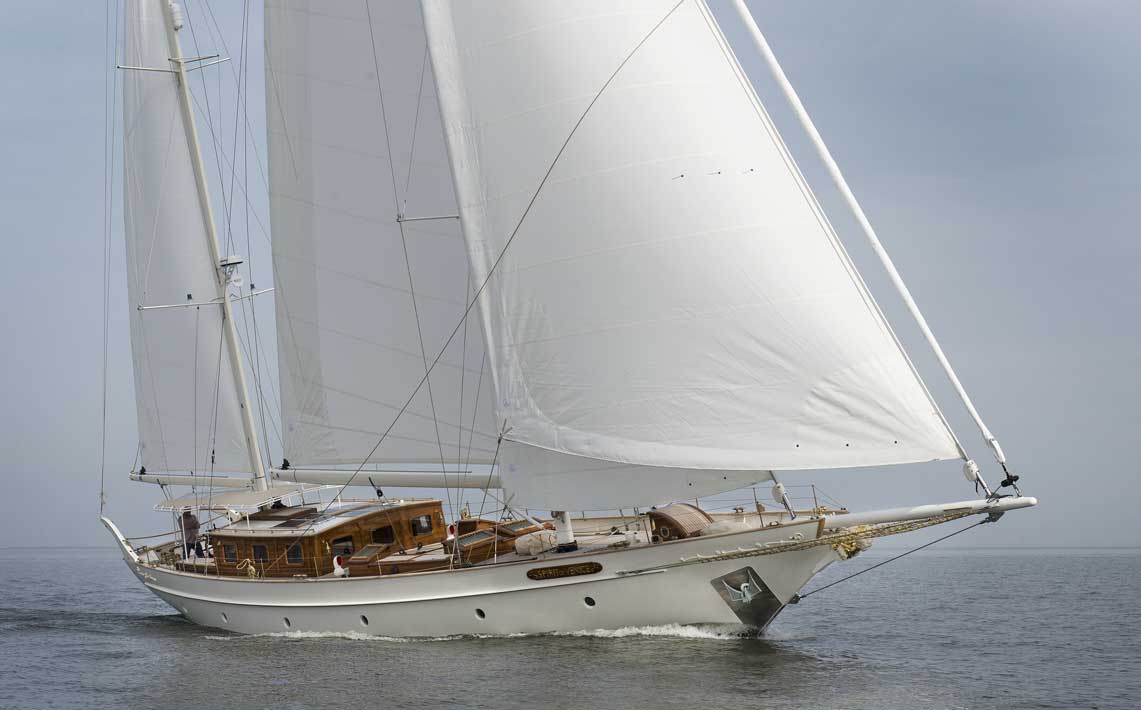
Spirit of Venice
A new olivier van meer custom design, built by vmg yachtbuilders, ready for her circumnavigation..
(text by Olivier van Meer).
After 50 years of dreaming, we built her owner the fast & able sailing yacht Spirit of Venice .
We first came into contact with the client in March 2015. He was especially charmed by the design of our Zaca® line but also had very specific wishes such as a foldable swim platform on the stern and some fantastic ideas for the interior. Once we started making sketches these quickly lead to an all-new design, albeit with recognizable Van der Meer elements such as the spacious deck saloon and decorative, but sturdy hull lines. This design also features our proven free up-running centre board, allowing the yacht with a minimal depth of 2.10 meters to enter small harbours and shallow sailing areas.
We chose an aluminium hull for this design (built by Dijkstra Metaalbewerking in Harlingen) and a Corecell/glass/epoxy composite deck, cockpit and superstructure (a specialism of VMG Yachtbuilders). This allowed for a good balance between cost, strength and weight. The aluminium hull has been reinforced to provide protection against floating materials at sea.
The owner, who is an experienced ocean sailor, wanted to be able to sail the yacht single-handed and had a strong preference for a gaff rig. All sails are therefore equipped with electric furling so that the yacht can be fully operated from behind the steering wheel. As always, we made sure that the design offers the best combination of speed and comfort, especially important here, as the owner intended to embark on some serious world trips. Spirit of Venice can be sailed from within the cockpit in bad weather, offering optimal protection against the elements.
In addition to the practical requirements, the owner had some very specific ideas in relation to the styling of the exterior and interior, which he wanted to be classic and playful, with lots of wood on the deck, as much bronze and brass as possible, and a keen eye for detail. Anything but standard, the result is a uniquely personal yacht, built to perfection by VMG Yachtbuilders.
Although we took care of the design and served as owner’s rep on the build, he himself was closely involved every step of the way. Building his own yacht was not only a life-long dream – he also wanted to savor the experience as much as he could. Toasting to a successful sea trial, I asked the owner why he’d chosen to work with us. “You were the only ones who really listened to what I wanted and design yachts from a life-at-sea perspective,” he replied. Duly noted!
All photos and illustrations: Olivier van Meer Design/VMG Yachtbuilders
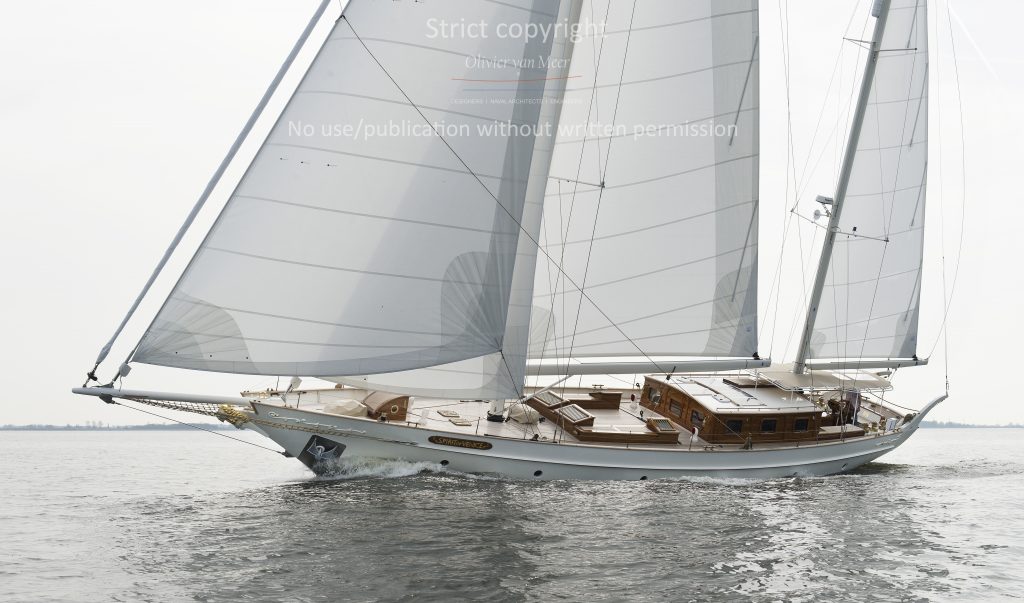
Looking for a service partner?
Practical Boat Owner
- Digital edition
The VMG 40 – a 40ft kit boat for bluewater cruising
- Katy Stickland
- June 23, 2023
VMG Yacht Design's VMG 40 can be built from a modular kit and is aimed at the offshore cruising market

he wide beam provides plenty of accommodation. Credit: VMG Yacht Design Credit: VMG Yacht Design
First look at the VMG 40
The Swiss firm VMG Yacht Design has just unveiled its plans for a 40ft cruising boat, which can be built from a modular kit out of plywood, epoxy, fibreglass or linen.
The design has been inspired by modern offshore racing yachts with wide beams, which provides plenty of accommodation below.
There are two layout options, although both offer a large master cabin in the forepeak, with two double cabins aft.

One of the two layout options available for the VMG 40. Credit: VMG Yacht Design
The galley can be L-shaped if desired.
There is a heads with shower, chart table and saloon to accommodate up to eight people.
Continues below…

First look at the BayCruiser 32
Swallow Yachts is now expanding its BayCruiser range with the BayCruiser 32

Bente 28: designed for sailing offshore
The new Bente 28 builds from the success of the Bente 24, and has been designed for cruising further afield

How to build a boat: Essential guide to building your first kit boat
On the upper reaches of the Thames, a rower slides gracefully along in his skiff. Meanwhile in Dorset, a dory…

Free boat plans – Build your own Nigel Irens 14ft rowing and sailing skiff
Fancy building your own Nigel Irens-designed 14ft rowing/sailing skiff? Nic Compton explains how to get the plans for free
Panoramic windows mean the main living area is bright.
The sail area is 85.7m2/922ft2, and the keel is available in two different draughts.
All the lines are led aft to the spacious cockpit, which has plenty of lazarette space for storage.

Aft, there is a swim platform. Credit: VMG Yacht Design
The VMG 40 is designed for a 30-50CV engine , with a 170lt fuel tank, 340lt fresh water tank, 60lt black water tank and 88lt grey water tank.
As well as the construction manual and the plans and technical documents, the VMG 40 kit includes pre-cut Okoumé CTBX for the hull, the structure, the deck and the cockpit with cut-outs for fixed glazing as well as lining frames and cut-outs for fixed and opening glazing.

The second layout option on the VMG 40. Credit: VMG Yacht Design
A keel pack with spare parts, rudder and steering system pack with spare parts and a rigging pack with the mast boom and standing rigging also comes with the full kit.
Pre-made kit for the interior furniture and a ready to assemble ironwork kit which includes chainplates, pulpits and stanchions are also available as options.
VMG 40 specifications
LOA: 11.95m/39ft 3in LWL: 11.00m/36ft 1n Beam: 4.30m/14ft 2in Draught: 1.7m/2.2m – 5ft 6in/7ft 3in Sail Area: 85.7 sq m/922.46sq ft Displacement: 6,000kg/13,227lbs Engine: 30-50CV Fresh water: 350 lt/76.96 gal Fuel: 170 lt/37.3 gal Black water: 60 lt/13.1 gal Grey water: 88 lt/19.35 gal Materials: Plywood, glass fibre or linen, epoxy Price: From €17,000/ £14,535 for the plans, technical documents and construction manual Contact: vmgyachtdesign.com
Enjoyed reading this article?
A subscription to Practical Boat Owner magazine costs around 40% less than the cover price .
Print and digital editions are available through Magazines Direct – where you can also find the latest deals .
PBO is packed with information to help you get the most from boat ownership – whether sail or power.
- Take your DIY skills to the next level with trusted advice on boat maintenance and repairs
- Impartial in-depth gear reviews
- Practical cruising tips for making the most of your time afloat
Follow us on Facebook , Instagram and Twitter
Velocity Made Good (VMG) – Definition and Application
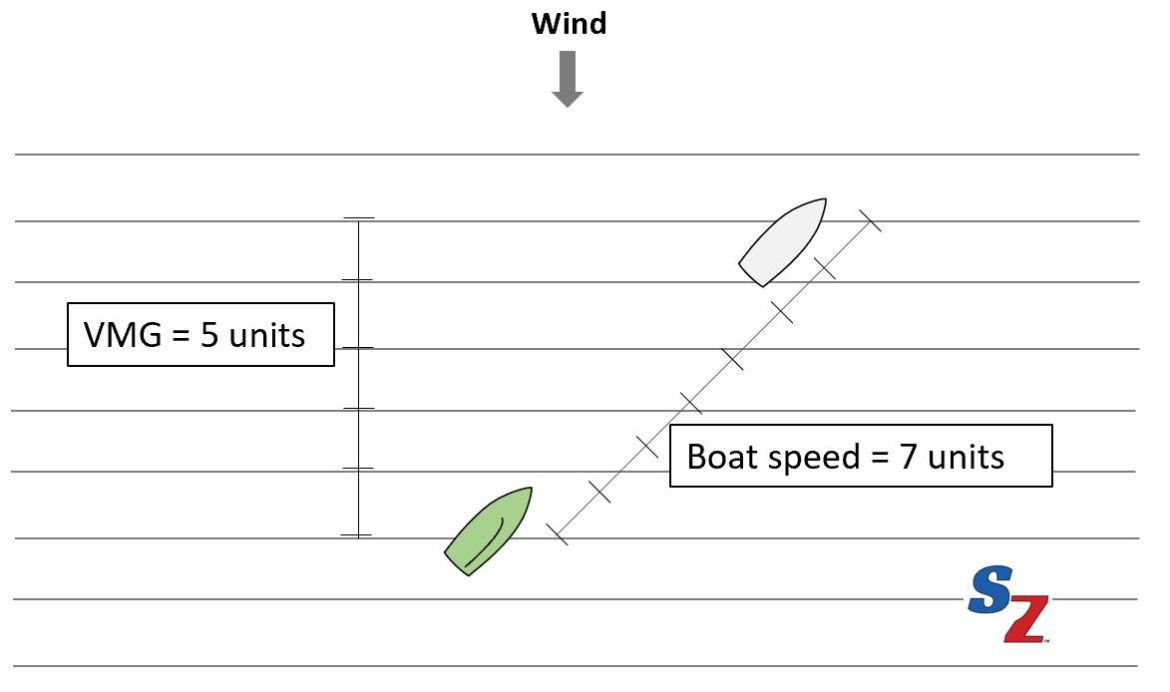
In this post we discuss Velocity Made Good or VMG. Many newer sailors are not familiar with this important concept, so we’ll discuss the definition and show some examples. Then we’ll discuss how to use the concept of target boat speed to maximize your VMG.
View the video or read through the text below.
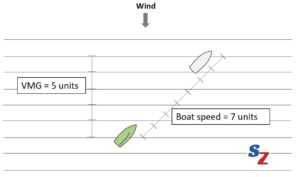
Velocity made good is the speed at which you are making progress directly upwind or directly downwind.
Here’s an example with some made up numbers. The blue boat sails upwind on a close hauled course at about 45 degrees to the wind. The boat travels 7 units of distance in the time period, so we’ll say it’s boat speed was 7 units. The scale on the left shows that the boat traveled 5 units of distance upwind in the same time period. So, the boat’s VMG in this case is 5 units.
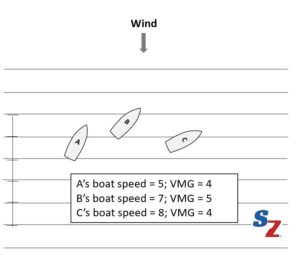
To show the importance of VMG, let’s compare the boat in the graphic above (Boat B in the graphic to the right) to two other boats sailing upwind.
Another boat (C) eases her sheets. C is reaching and sails faster, but at a lower heading than B. Her boat speed is 8 units in the same time period. She advanced 4 units upwind, so her VMG is 4 units.
Still another boat (A) decides to sail closer to the wind, so she sheets in tightly and heads up. She is pinching and her speed is 5 units. Her VMG is also 4 units.
These are made up numbers, but they illustrate that VMG depends on your boat speed and your heading.
Why is Velocity Made Good Important?
VMG measures how fast you are making progress directly upwind (or downwind). Therefore, if you’re sailing windward/leeward courses, the boat that has the highest average VMG wins the race. It’s that simple. If this puzzles you, go back and review our post on ladder rungs .
If the course is a reach, then VMG doesn’t matter – it’s straight line boat speed that matters.
Realize that it’s your average VMG that matters. You won’t always sail at your best VMG: sometimes you will pinch or foot, or even sail on a header to get to a favorable shift or puff. But if you find that favorable shift or puff, it will greatly increase your VMG.
Top sailors don’t spend a lot of time talking about VMG or trying to measure. The concept is important, but measuring it is not very important. To measure it, you need instruments that sense the actual wind speed and direction and track your progress upwind or downwind. Big keel boats have these instruments, but even for them, VMG changes so rapidly that it’s not useful.
Instead, we use other indicators to sail at max VMG. We’ll talk about these more below.
Maximize your VMG with Target Boat Speeds
One way to think about VMG is a concept called target boat speed. Keel boats use instruments to maximize VMG by sailing at target boat speeds.
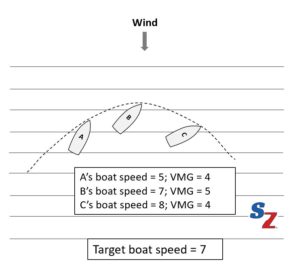
To understand target boat speed, let’s review our previous examples.
- Boat A had a boat speed of 5 and a VMG of 4.
- Boat B sailed at 45 degrees to the wind and had a boat speed of 7 and a VMG of 5.
- Boat C footed off and had a boat speed of 8 and a VMG of 4.
So, Boat B had the maximum VMG of these three boats. Let’s assume that B chose the very best combination of speed and sailing angle.
In the drawing above, notice the curve (dotted line) showing how far upwind boats would get if they sailed at different angles upwind. Assuming they were all trimmed up properly for their chosen headings, they would end up somewhere on the curve. This curve shows that a boat speed of 7 maximizes your VMG in this case. So, for this wind and these fictional boats, we would say that the target boat speed is 7.
So, the target boat speed is the speed at which your velocity made good is maximized for a given wind speed, assuming proper trim. If your boat is sailing above the target speed, like C, you’re footing. If your boat is sailing below the target speed, like A, you’re pinching.
Racing keelboats have instruments with target speeds programmed into them for each wind speed. On these boats, the helmsman and crew adjust the boat’s heading and trim until they match the target.
Target Speed and Puff Response – Upwind
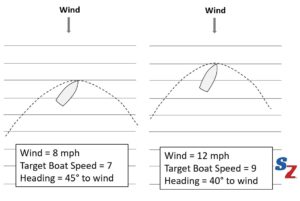
When sailing upwind, many sailors have trouble getting the most out of the boat in a puff. The target speed concept can help you understand the best way to respond and maximize your VMG.
First, realize that target speed and heading angle are different for each wind speed. In our first example the target speed was 7. Let’s assume that occurred with the true wind at 8 mph and the heading of 45 degrees to the true wind.
If the wind increases to 12 mph, the target speed and heading will change. Let’s say that it changes to a target speed of 9 and a heading of 40 degrees.

Puff Response
If you’re sailing in an 8 mph wind and a puff of 12 mph comes along that lasts several seconds, how should respond to maximize your VMG? Should you head up to the 40 degree angle first? Or worry about the target speed?
If you think about target speeds, you will realize that your target boat speed increases when the puff hits, and so you must gain speed to get to the new target. If you head up first, you won’t build speed rapidly. You might even slow down if you head up too quickly.
Instead, you need to focus on getting to the new target speed as quickly as possible. Increase your speed by easing the sail and holding your heading steady or feathering up just a bit. During this speed building time, you’re sailing below the new angle of 40 degrees.
Once you build speed, you can head up fully to the new 40 degree angle.
Lull Response
Next think about the proper lull response. Let’s reverse the above situation. You’re sailing in 12 mph breeze at your target of 9, and along comes a lull to a wind of 8 mph. How should you react?
Hopefully, you can see that your new target speed is lower. To get to that new target quickly, hold your heading, even though you are sailing too high for the 8 mph wind. This will bleed off your speed quickly, and also let you make more progress upwind for a short time. Once your speed is down to target, you can bear off to the lower heading.
Maximizing VMG Downwind
just like upwind, there is a target boat speed and sailing angle that maximizes your velocity made good downwind.
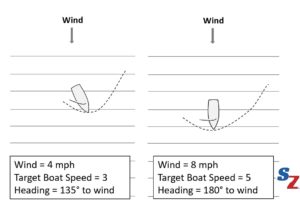
In light air, most boats sail very slowly if they head dead downwind. To compensate, we head up to gain speed. The extra speed more than compensates for the extra distance we sail. Using made up numbers, if the wind were 4 mph, we might sail at a heading of 135 degrees to the wind to build to a speed of 3 mph. Boats that sail low might point closer to the mark, but make less progress. Boats that sail higher will go faster, but will also make less progress. This relationship is indicated by the dotted curves.
In heavier air, we can sail lower and still maintain higher speeds. In this example, if the wind is 8 mph, we might be able to sail dead downwind at 5 mph, maximizing our VMG. Thus, the dotted curve for 8 mph show a max VMG when heading straight downwind.
This is one of the reasons for the downwind advice to “sail up in the lulls and down in the puffs.” Following this advice blindly is not the best way to maximize VMG.
Puff and Lull Response Downwind
If you’re reaching up a little to get more speed in light air, and a puff comes along, should you head down immediately?
Just like the upwind response, the answer is to adjust your trim and hold your heading or feather down only slightly to build to your target speed as quickly as possible first. Then head down.
For a lull, bleed your speed while gaining distance downwind, before you head up. This might only take a few seconds.
Notes About Target Speed
Don’t worry about the math and geometry. It’s the concept, that there is a best speed and associated heading angle to maximize your VMG. The sailors that keep their boats at or near target speed will make the most upwind or downwind progress.
Since we don’t have instruments, we need other cues to tell us when we’re at target speed. Here are some:
- The target speed concept is based on sailing your boat as fast as possible for the heading – that means proper sail trim, angle of heel, and hiking. If you’re not doing that, then by definition you’re not sailing at target speed.
- Once you learn how to responds to puffs and lulls properly, you will feel the difference and will want to get that feel every time.
- You can always tell if you’re gaining on other boats by comparing ladder rungs. See our video on ladder rungs for how to do this.
“Fudging” on Target Speed
Of course, there are situations when you may not want to sail strictly at target speed. These include the following:
- Tactical or strategic positioning situations
- Waves, where you might want to foot a bit to power through
- Cases in which your boat’s speed limits (such as hull speed) and performance characteristics blur the target speed concept. We’ll discuss this idea in another post.
VMG (Velocity Made Good) – eye-catching video from Oracle Team USA VMG to Wind Calculator – just for fun from L-36.com
Two-Boat Testing: Worth the Effort
Shaping your mainsail, part 2: camber, you may also like, three reasons to get fit for sailing, prevent breakdowns – top tips, updated, bill draheim on shroud telltales, sportvid – laser sailing upwind, sailing terms from l-36.com, downwind sailing and gybing tips from sarah..., upwind sailing tips by sarah ayton &..., optimist sailmakers and manufacturers tuning guides, optimist mast rake and downwind heel –..., upwind boat speed – sailzing aha insights.
This was a great article/commentary. I have often heard the term but never really understood it until now. Thanks a lot. Adrian
Thanks for the feedback! Let us know what other content you’d like to see.
Bin durch Zufall auf Eure tolle ! Seite(n) gestoßen; was ich bis jetzt gelesen habe ist klasse – ich hoffe, ich kann meine Jungs jetzt besser überzeugen ! – is german ok here or are all you guys US and others ?
Welcome Klaus! Deutsch is certainly welcome! Happy to have you share any sailing tips that you have. -Rob
Leave a Comment Cancel Reply
You must be logged in to post a comment.
This site uses Akismet to reduce spam. Learn how your comment data is processed .
Insert/edit link
Enter the destination URL
Or link to existing content

What is VMG?
Vmg – velocity made good and polar plots.
This discussion comes mostly out of our Electronic Navigation Course which is available also as an iPad Electronic Navigation Course App .
For sailboats, VMG is slightly different than what you’d expect if you were navigating an airplane or power boat. For airplanes and powerboat VMG is your velocity in the direction of your destination. It can differ from your actual velocity because of wind in the case of an airplane or current in a powerboat. But with no wind or current, your VMG is equal to your vessel speed.
In a sailboat – VMG is the velocity component of the boat in an upwind (or downwind) direction. The distinction is made because sailboats inherently can not head in an upwind direction but it is important information to know. And as you’ll know soon a sailboat can reach a downwind destination faster if it bears off a little rather than heading dead downwind. Thus some manufacturers make the distinction between power and sail by using the defined terms VMC and VMG.
VMC is the Velocity Made good on Course. i.e. Speed in the direction of the mark. VMG is the Velocity Made Good i.e. Speed in the upwind of downwind direction.
Some manufacturers don’t bother with us sailors and some manufacturers do but don’t use VMC . The trick is to just know the difference and know what information you are looking at.
Since Manufacturers don’t distinguish – in this post we have attempted to point out each time if VMC or VMG is being used.
It is important to point out that these methods were the only choice in the days before PCs, mobile devices and GPS. We’ll go through the original method below for your understanding, but there are simpler, faster, low-cost methods available now. For example, the SailTimer Charts Edition app is free in the US. Simply by entering your waypoint and the wind speed and direction, it will overlay your optimal tacks on the chart and tell you your Tacking Time to Destination.
Here below we have created an interactive animation to help understand this concept with a dual benefit of learning how a polar plot for a sailboat works. If you’re new to sailing – don’t worry – this explanation will teach you a lot about sailing and you’ll come out knowing more on this topic than most sailors – mostly because of poor existing textual explanations of polar plots. Yay – go NauticEd interactive animations!
A polar plot is simply a graph of the boat’s speed in all different wind directions. In the old days, if you were a sponsored racing team, you could spend a lot of money on a computer simulation to get a polar plot of your boat’s estimated speeds, if you provided the boat model, hull shape, displacement, length and so on. A few manufacturers also provided these (although naturally the manufacturers may be overly optimistic about their boat’s performance in marketing materials). Fortunately, in the age of GPS, an app like the SailTimer app can easily record your boat’s speed in various wind conditions and generate a custom polar plot for your individual boat. That is actual data, not generic polars for all boats of a particular model, estimates or marketing materials. That gives you the most reliable indicator of boat speeds for determining tacking angles and arrival times.
When you click on any of the numbers in the green stripe, the sailboat moves to that angle of attack to the true wind. Go ahead and click around randomly a little to start with. Note that the boat will lie on the backwards facing strange looking “C” curve anytime you click on a wind angle. For example, if you click on 90, the boat will move to the outer right of the C curve and lie on the 90 degree line. Simultaneously, you’ll notice that the wind meter below also represents the true wind angle and shows the boat speed. And one more thing – notice that we have also overlaid the optimum position of the sails according to the wind angle for you new sailors.
Understanding the Polar Plot
Alrighty then, let’s work through this logically. One thing that always perplexes new sailors (and some old) is what is the best angle to sail at to get to an upwind destination the fastest. Do you sail close to the wind but with lower speed or do you trade out angle with a higher speed? The answer lies directly in a polar plot. A polar plot C curve is a graph that is plotted unique to each boat type and the C curve follows the performance of that boat at a specific true wind speed AND assuming that the sails are set at their optimum. For example, in the polar plot presented here, if you click on 60 degrees the boat speed will be 8 knots as shown by the wind meter AND also found by following the arc of the polar plot around to the vertical speed line. Similarly, 90 degrees will also render 8 knots. 150 degrees 6.9 knots. With each angle, all you do is follow an arc starting from the intersection of the C curve and the radial angle line around to the vertical line. Simple!
Back to the question at hand – which is the best angle to head to get the fastest upwind or downwind speed? Well, notice that when you click on an angle on the green stripe the wind meter gives boat speed. This is speed through the water in the direction the boat is pointing. But it’s not giving the VMG (velocity of the boat in an upwind direction). Many high-tech GPS Chart plotters (like the B and G Zeus discussed in the Electronic Navigation Course) do display VMG automatically these days and they distinguish between VMG and VMC.
Unfortunately, most other chart plotters do not clarify whether their display of VMG refers to Velocity to the Mark (VMC) or to the Wind (VMG). Velocity to the Mark works in aircraft, vehicles and powerboats, but is not correct when used on sailboat tacks (see www.SailTimerApp.com/VMG.html for a full explanation). This could be a dangerous situation, so you should only use VMG on chartplotter hardware if it actually specifies that it is VMG to the Wind that is being displayed. VMG to the Mark (VMC) is useful on powerboats, but it not meaningful or reliable on sailboats when tacking to an upwind waypoint.
From the polar plot, it’s also easy to find the VMG because by definition of sines and cosines of the angles if you draw a line horizontally across to the vertical speed line – that is your VMG. For an easy example – if your boat was heading 90 degrees to the true wind – obviously you’re not making any upwind headway. From the plot, the 90 degree line renders zero at the vertical speed line – of course. Now look at 80 degrees, You’d be making 2 knots VMG with 8 knots boat speed. Once you grasp this its easy to see exactly what renders the highest VMG. Its a horizontal line that is the highest on the plot that barely touches the C curve. e.g. click on 40 degrees. You’ll see that this renders the best VMG of 5.2 knots whilst the boat is doing 6.9 knots. No other horizontal line can be higher that touches the C curve.
So here we have answered the question of should I head more upwind and lose speed or crack off a little and while losing angle to gain speed. The answer is right in the polar plot. Draw a horizontal line tangent to the top of the polar plot then bring a radial line down to the center and measure that angle. Traditionally, that’s the true wind angle you give to your helmsperson to sail to in order to beat the competition. Know however that this is true wind angle not apparent wind angle. AND also know however that, as easy as it may seem for an electronic device to calculate, true wind determination is not that easy – see the discussion on this in our Electronic Navigation Course. At this angle, you also give the theoretical boat speed number to your sail trimmers. If your boat is not at this speed than according to the manufacturer, you’re not trimmed optimally.
Of course, unless you have a full-time tactician on board, and an accurate display/calculation of true wind it is not really practical to be working with a polar plot so hard. But the SailTimer app is an example of a modern program that can do precise calculations automatically, to show you the optimal tacking angles based on the actual polar data for your individual boat, along with the distance on each tack and the overall Tacking Time to Destination (TTD).
The SailTimer tacking results do not rely on VMG or raise questions about whether you are using VMG to the Mark (VMC) or to the Wind (VMG), it simply finds the fastest route based on tacking distances and boat speeds from your polar plot. One of the other disadvantages of any VMG is that it can only be calculated while you are actually moving. In contrast, you can get the free Sailtimer app and plan out tomorrow’s trip at your desk or on the dock before you go, to see the optimal tacks and TTD (Time to Destination) for any given wind forecast.
VMG Downwind
So now take a look at the downwind sailing scenario. If you click on 180 degrees you’ll see that the boat is making 5.1 knots direct down wind. But what if the helmsperson cracked off some to try to add in some positive apparent wind effect? You can see that the C curve dips down most out at 140 degrees. This will render a higher boat speed of 8 knots AND a higher downwind VMG of 5.7 knots compared to 5.1 at 180. 5.7 comes from the horizontal line touching the lowest point of the C curve. Where that intersection occurs you measure the angle around the polar plot, giving 140 degrees in this instance.
WOW so it is true! Heading off at an angle downwind will get you home faster. YUP and the proof is right here in the polar plot not on the water (so long as your polar plot looks like this).
With on board electronic devices that are properly tuned, you can view some pretty amazing information. This information can really make a difference to performance speed. The NauticEd Electronic Navigation course uses the B and G Zeus device as an example of an excellent piece of equipment that you’d be well served to have on board. The course takes you through the whole device as an example of most any manufacturers equipment and shows all the theory behind the information you are being feed. You’ll also learn how to get into the screen guts and display the right information that is pertinent to your desires.
These days, sailboat navigation apps are also evolving quickly. The SailTimer app is one example that can graph the day’s wind speed, display your GPS track, and show your optimal tacks (see www.SailTimerWindVane.com/iOSapp.html).
As one other illustration of how marine electronics and sailboat navigation have changed in the digital age, we can also look at “ETA”. That is a common term that many people refer to; Estimated Time of Arrival. But if you have ever used a GPS chartplotter when on a long tack, you may have wondered how accurate the ETA display actually is. Does the device know when you are going to tack, or your tacking distances? If not, how can it display a correct ETA? This is why this course is invaluable for you. Although ETA is widely used on GPS chartplotters and pretty much all sailboats, sometimes the established methods take a long time to change, even if they are based more on marketing than accurate information. Since some GPS chartplotters don’t know your tacking distances, many in fact use the traditional method of calculating your VMG to the Mark (VMC), to estimate your ETA. But VMG to the Mark is not reliable in sailboats. Fortunately, with apps like the free SailTimer app ( www.SailTimerApp.com ), you can easily display your Tacking Time to Destination (TTD) instead of ETA.
Take the NauticEd Electronic Navigation Course now – even if you don’t have a boat or electronics on board – you’ll learn a lot about sailing and navigation which will be helpful for Bareboat Charter Sailing Vacations and understanding what navigation/heading decisions the captain is making regarding VMG and other information.
Here is the iPad Electronic Navigation Course App
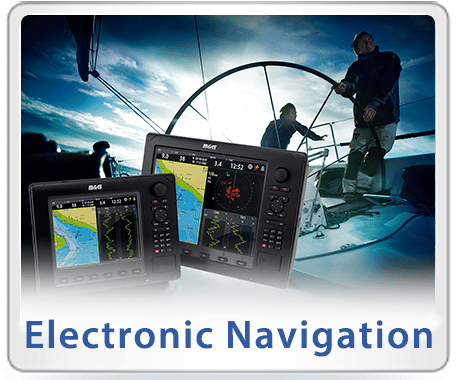
Electronic Navigation Course
- Recent Posts
- Sail on the Clipper Stad Amsterdam - January 26, 2024
- Catamaran Vacation Training in Puerto Rico - January 6, 2024
- Catamaran Sailing Training in Houston Texas - January 2, 2024
You might also like
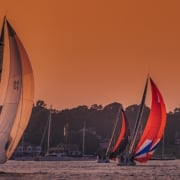
TWEET ABOUT

FIGHT CHILDHOOD CANCER
NauticEd is a fully recognized education and certification platform for sailing students combining online and on-the-water real instruction ( and now VR ). NauticEd offers +24 online courses , a free sailor's toolkit that includes 2 free courses, and six ranks of certification – all integrated into NauticEd’s proprietary platform. The USCG and NASBLA recognize NauticEd as having met the established American National Standards. Learn more at www.nauticed.org .

The NauticEd Vacations team are Expert Global Yacht Charter Agents – when you book a sailing vacation or bareboat charter through NauticEd, we don’t charge you a fee – we often save you money since we can compare prices from all yacht charter companies. PLUS, we can give you advice on which destination or charter company will suit your needs best. Inquire about a Sailing Vacation or Charter .
Online Sailing Courses Sailing Vacations | Charters Practical Sailing Courses Sailing Certification | License
Sign up for 2 FREE Sailing Courses Try sailing in Virtual Reality! Gift a Friend a Sailing Course Sailing Events | Opportunities
About NauticEd Contact Us NauticEd Support Privacy Policy

Please use a modern browser to view this website. Some elements might not work as expected when using Internet Explorer.
- Landing Page
- Luxury Yacht Vacation Types
- Corporate Yacht Charter
- Tailor Made Vacations
- Luxury Exploration Vacations
- View All 3567
- Motor Yachts
- Sailing Yachts
- Classic Yachts
- Catamaran Yachts
- Filter By Destination
- More Filters
- Latest Reviews
- Charter Special Offers
- Destination Guides
- Inspiration & Features
- Mediterranean Charter Yachts
- France Charter Yachts
- Italy Charter Yachts
- Croatia Charter Yachts
- Greece Charter Yachts
- Turkey Charter Yachts
- Bahamas Charter Yachts
- Caribbean Charter Yachts
- Australia Charter Yachts
- Thailand Charter Yachts
- Dubai Charter Yachts
- Destination News
- New To Fleet
- Charter Fleet Updates
- Special Offers
- Industry News
- Yacht Shows
- Corporate Charter
- Finding a Yacht Broker
- Charter Preferences
- Questions & Answers
- Add my yacht
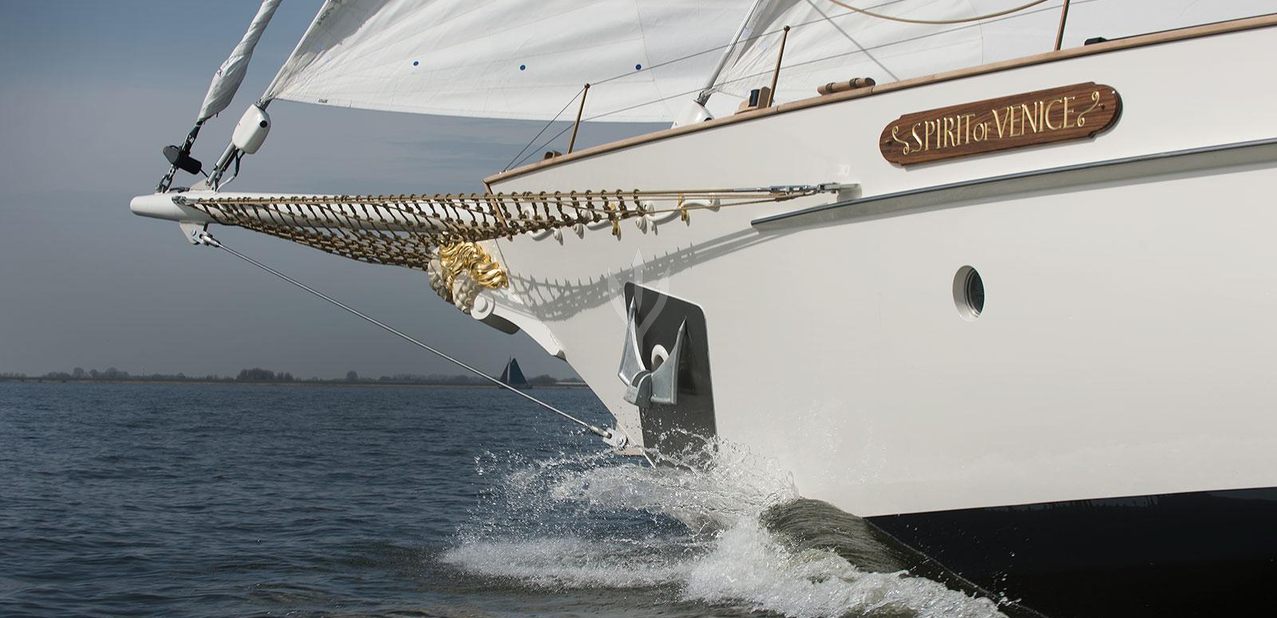
NOT FOR CHARTER *
This Yacht is not for Charter*
SIMILAR YACHTS FOR CHARTER
View Similar Yachts
Or View All luxury yachts for charter
- Luxury Charter Yachts
- Sailing Yachts for Charter
Spirit of Venice
- Amenities & Toys
SPIRIT OF VENICE yacht NOT for charter*
27.32m / 89'8 | vmg yachtbuilders | 2018.
Owner & Guests
Cabin Configuration
- Previous Yacht
The 27.32m/89'8" gulet yacht 'Spirit of Venice' was built by VMG Yachtbuilders . Her interior is styled by design house Olivier F. van Meer and she was delivered to her owner in April 2018. This luxury vessel's exterior design is the work of Olivier F. van Meer.
Guest Accommodation
Spirit of Venice has been designed to comfortably accommodate up to 6 guests in 3 suites.
Range & Performance
Spirit of Venice is built with a aluminium hull and wood superstructure, with composite decks. Powered by 1 x diesel Volvo Penta 6-cylinder 202hp engines running at 1900rpm, she comfortably cruises at 8 knots, reaches a maximum speed of 12 knots. Her water tanks store around 1,730 Litres of fresh water.
*Charter Spirit of Venice Sail Yacht
Sail yacht Spirit of Venice is currently not believed to be available for private Charter. To view similar yachts for charter , or contact your Yacht Charter Broker for information about renting a luxury charter yacht.
Spirit of Venice Yacht Owner, Captain or marketing company
'Yacht Charter Fleet' is a free information service, if your yacht is available for charter please contact us with details and photos and we will update our records.
Spirit of Venice Photos
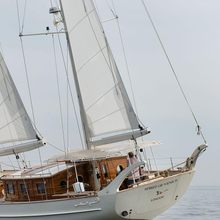
NOTE to U.S. Customs & Border Protection
Specification
S/Y Spirit of Venice
SIMILAR LUXURY YACHTS FOR CHARTER
Here are a selection of superyachts which are similar to Spirit of Venice yacht which are believed to be available for charter. To view all similar luxury charter yachts click on the button below.
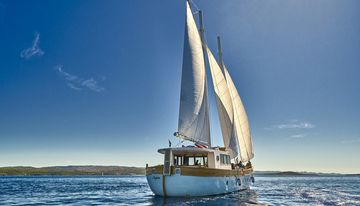
28m | Custom
POA ♦︎
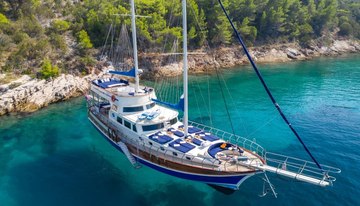
26m | Fethiye Shipyard
from $19,000 p/week ♦︎
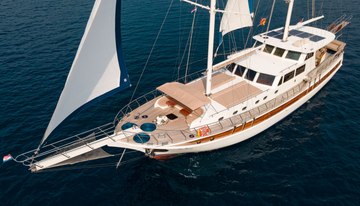
from $22,000 p/week ♦︎
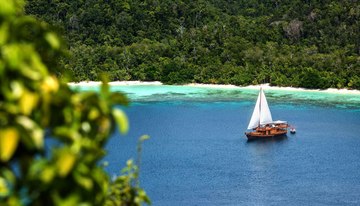
26m | Bugis
from $87,500 p/week
As Featured In
The YachtCharterFleet Difference
YachtCharterFleet makes it easy to find the yacht charter vacation that is right for you. We combine thousands of yacht listings with local destination information, sample itineraries and experiences to deliver the world's most comprehensive yacht charter website.
San Francisco
- Like us on Facebook
- Follow us on Twitter
- Follow us on Instagram
- Find us on LinkedIn
- Add My Yacht
- Affiliates & Partners
Popular Destinations & Events
- St Tropez Yacht Charter
- Monaco Yacht Charter
- St Barts Yacht Charter
- Greece Yacht Charter
- Mykonos Yacht Charter
- Caribbean Yacht Charter
Featured Charter Yachts
- Maltese Falcon Yacht Charter
- Wheels Yacht Charter
- Victorious Yacht Charter
- Andrea Yacht Charter
- Titania Yacht Charter
- Ahpo Yacht Charter
Receive our latest offers, trends and stories direct to your inbox.
Please enter a valid e-mail.
Thanks for subscribing.
Search for Yachts, Destinations, Events, News... everything related to Luxury Yachts for Charter.
Yachts in your shortlist

Creating the future classics for the master mariner.
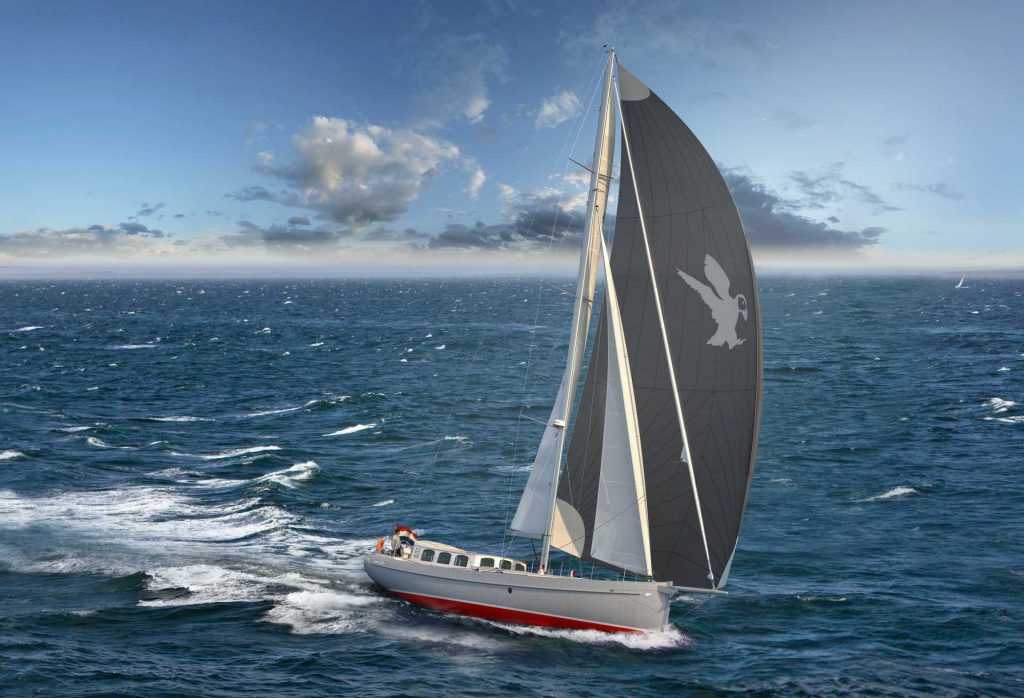
Serving Master Mariners for years
Puffin yachts are designed by Olivier van Meer and built by VMG Yachtbuilders in Enkhuizen, the Netherlands. Puffin ® yachts are built according to the highest quality standards to provide safety and comfort during long distance sailing and onboard living. Puffin ® yachts are made to be sailed by a short-handed crew and equipped with a fixed keel or a retractable center board which enables cruising in shallow waters and drying out on any bottom.
From 2021 every Puffin® yacht starts with a standard specification. Fixed are the outspoken characteristics like the bowsprit, window shape, heartshaped transom and tumble home. All of these details together guarantee excellent sailing characteristics and give a Puffin ® yacht its sturdy and classic looks.
The line of Puffin® yachts will be limited to 3 standard models: 42, 50 and 58. These models will be built in centerboard and fixed keel versions. Furthermore we developed an interior that allows us to produce it in a more sophisticated and economic way, which results in a competitive price for the yachts. An owner can still customize his/her yacht in to a large extent, when it comes to layout, material, colors, rig etcetera.
2021 is the year of the biggest design change in a Puffin® yacht so far, but she will not lose any of her charm. By modernizing and bringing various standard models to the market, we hope to inspire you in your search for a new boat.
Film premiere: Puffin® featuring Olivier van Meer
5 details that makes the Puffin unique
Fixed bowsprit, panoramic decksaloon, heartshaped transom, stable tumblehome, signature sheerline, building the future classics, that’s what we do, vmg yachtbuilders.
Craftsmanship combined with the most up-to-date and sophisticated production methods and machines are key for our yard to realize all our client’s nautical wishes.
From complete custom yacht building to refits, from teak deck applications to restoration of old classical yachts and all carpentry inside and out.
Puffin ® yachts are designed by Olivier van Meer and built by VMG Yachtbuilders in Enkhuizen, the Netherlands. All Puffin ® yachts meet the highest quality standards to provide safety and comfort during long distance sailing and onboard living.
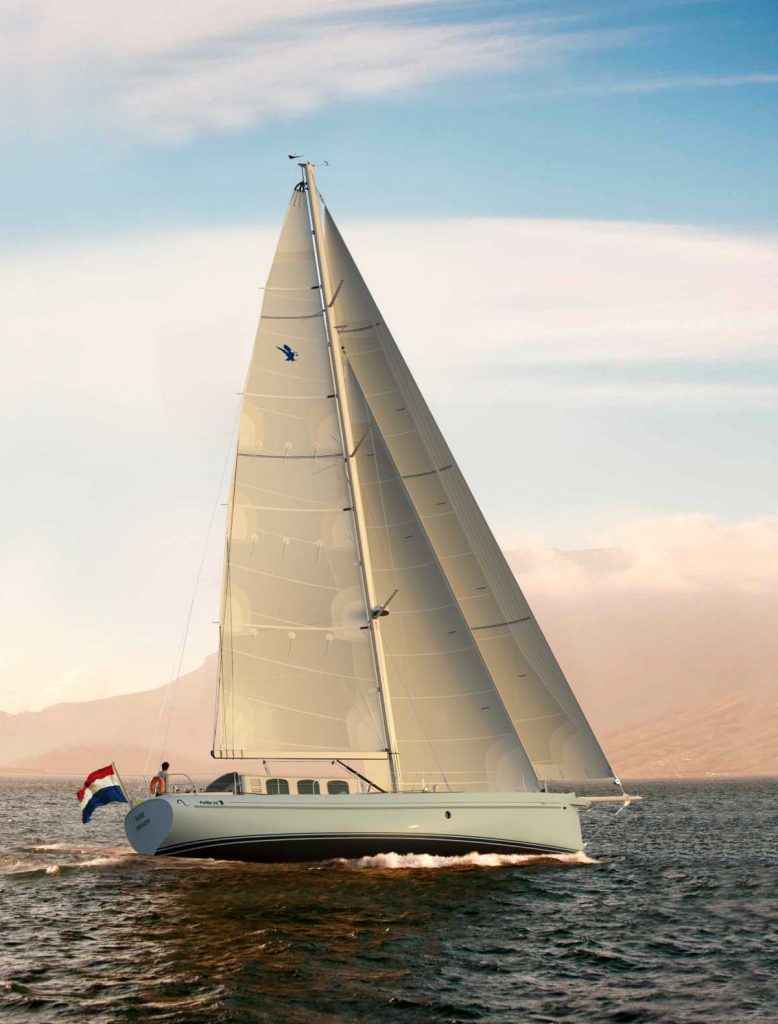
Our passion
Handcrafted by experts, designed by masters.
Born on a gaff schooner, Olivier van Meer had sailed over 100.000 miles before he became the youngest licensed captain in the Netherlands.
He produced his first designs as a teenager and during his early professional sailing career on yachts and professional sailing and motor vessels.
These designs were often inspired by the maritime environment of his sailing area.In 1985, Olivier decided to follow his dreams and founded the OVM office for naval architecture, design and engineering, surrounding himself with specialists who shared his passion.This team represents the OVM signature – the search for the ultimate lines, up-to-date know how, and perfect design skills, combined with practical experience over many nautical miles.
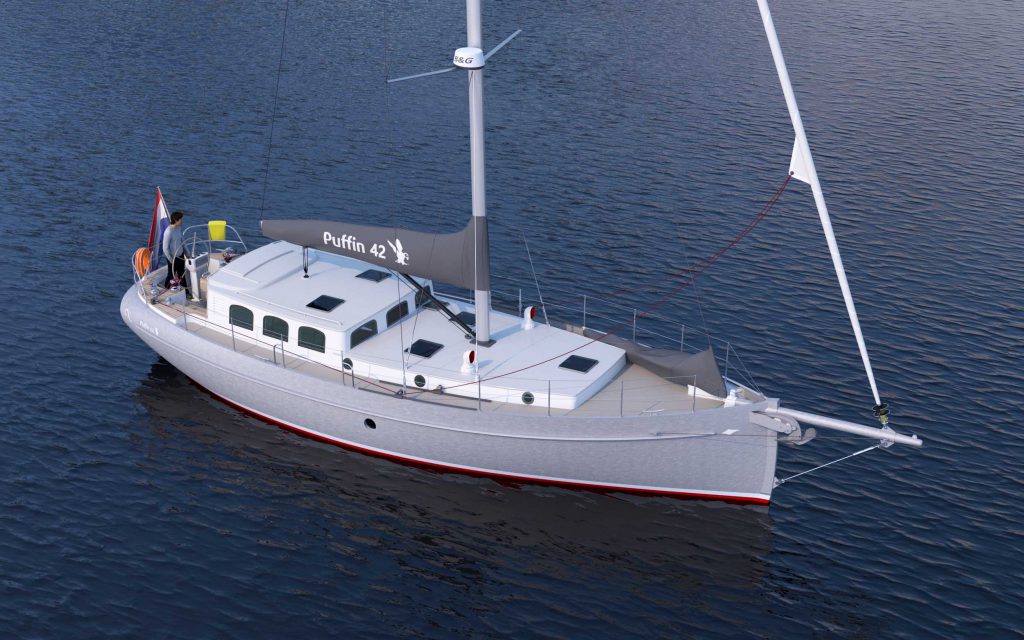
Creations we are proud of
Every Puffin ® yacht is extremely sturdily built – a boat that will outlive you! Quite apart from our own views on strength, the construction and welding are more the kind of thing you would expect to find in commercial shipping than in yachting. The optimum length/width ratio offers a surprisingly large amount of space for present-day comfort, unlike many yachts of similar length.
Puffin ® yachts can be built with a normal keel or with a centerboard. The hull is always produced in aluminum.
Puffin 2021
SNEAK PREVIEW: 2021 is the year of the introduction of the complete new Puffin® range. The line of Puffin® yachts will be limited to 3 standard models: 42, 50…
Puffin 50 ‘Jaleo’ set sail to the Mediterranean
After a building period of exactly 1 year we delivered Puffin 50 ‘Jaleo’ to its new captain. She will set sail for a trip along the Iberian coasts and…
Puffin nr. 1 sold at VMG Yachting
Quote For Sail Yachtbrokers “For some years now we have been dealer for the brand Puffin. The design of the Puffin is by Olivier van Meer and the…
Please leave this field empty.

VMG YACHTs yokohama
Italia yachts, find a new yachts .
LUXURY Performance Cruiser
Sports Model Fuoriserie
ITALIA 9.98 34FT
ITALIA 11.98 39FT
ITALIA 12.98 44FT
ITALIA 14.98 50FT
Blue Water Model Bellissima
ITALIA 16.98 54FT
ITALIA 20.98 72FT
IY 43 Veloce 43FT
Dehler Yachts
GERMAN Brand
Performance
Cruising Cruiser
Racing Boat
Dehler 30 One Design
Dehler 29
Dehler 34
Dehler 38 SQ
Dehler 42
Dehler 46 SQ
ZODIAC I.R.BOAT
Rigid Inflatable Boat
Sailing Coach Boats

Marine Equipment・Hardware・Elictronics

ITALIA YACHTS 日本総輸入販売ディーラー
ITALIA YACHTS Exclusive Dealer in JAPAN.
イタリア ヨットは、2011年ベネチアで生まれ急成長してるニュービルダーです。
ITALIA YACHTSのコンセプトは、 スポーツラインと ブルーウオーター ライン,
と2タイプありますが、1つのHULL モデルより 2タイプのモデルを創り出しています。
どちらも帆走性能に優れる パフォーマンス セーリングクルーザーです。
ブルーウオーター クルーザー ボートも スポーツモデルのDNAを受け継いでいる、
帆走性能に優れているセーリング クルーザー です 。
2019 年10月よりVMG YACHTSは、ITALIA YACHTS
Japan Exclusive Dealer に任命されました。
2021年 4月 日本初号艇となるITALIA 11.98 Bellisshima 11 号艇が進水しました。
そして、2023年3月 ITALIA 11.98 Fuoriserie 日本2号艇も進水しています。
日本のセーリングファンの皆様にITALIA YACHTS BLANDを広め、
日本の海に多くのITALIA YACHTSを進水していく次第です。
海 外 輸 入 艇 ・仲介 / 輸入代行
ITALIA YACHTS
日本総輸入元 ・仲介 / 輸入 代行
Dehler Yachts
ZODIAC Boats
海外中古艇輸入代行
- POWER Plant ID
- POWER Events
- Connected Plant
- Distributed Energy
- International
- COVID-19 Coverage
- Carbon Capture
- Climate change
- Cybersecurity
- Distributed Power
- Electric Vehicles
- Energy Storage
- Environmental
- Instrumentation & Controls
- Legal & Regulatory
- Legislative
- Ocean/Marine
- Physical security
- Plant Design
- Power Demand
- Research and Development
- Supply Chains
- Tidal Power
- Waste to Energy
- About POWER
- Privacy Policy
- Diversity, Equity, Inclusion & Belonging
- Accessibility Statement
New modification of Russian VVER-440 fuel loaded at Paks NPP in Hungary
DECEMBER 14, 2020 — After the recent refueling at power unit 3 of the Hungarian Paks NPP, its VVER-440 reactor has been loaded with a batch of fresh fuel including 18 fuel bundles of the new modification. The new fuel will be introduced at all four operating power units of the Paks NPP, and the amount of new-modification bundles in each refueling will be increased gradually.
Development of the new VVER-440 fuel modification was completed in 2020 under the contract between TVEL JSC and MVM Paks NPP Ltd. Its introduction would optimize the hydro-uranium ratio in the reactor core, enabling to increase the efficiency of fuel usage and advance the economic performance of the power plant operation. All VVER-440 fuel modifications are manufactured at the Elemash Machine-Building Plant, a facility of TVEL Fuel Company in Elektrostal, Moscow Region.

“Introduction of a new fuel is an option to improve technical and economic performance of a nuclear power plant without substantial investment. We are actively engaged in development of new models and modifications of VVER-440 fuel for power plants in Europe. The projects of the new fuels for Loviisa NPP in Finland, Dukovany NPP in the Czech Republic, Mochovce and Bohunice NPPs in Slovakia, are currently at various stages of implementation. Despite the same reactor model, these projects are quite different technically and conceptually, since we take into account the individual needs and requirements of our customers,” commented Natalia Nikipelova, President of TVEL JSC.
For reference:
The project of development and validation of the new fuel has been accomplished with participation of a number of Russian nuclear industry enterprises, such as OKB Gidropress (a part of Rosatom machine-building division Atomenergomash), Bochvar Institute (material science research facility of TVEL Fuel Company), Elemash Machine-building plant and Kurchatov Institute national research center. At the site of OKB Gidropress research and experiment facility, the new fuel passed a range of hydraulic, longevity and vibration tests.
Paks NPP is the only functioning nuclear power plant in Hungary with total installed capacity 2000 MWe. It operates four similar units powered by VVER-440 reactors and commissioned one by one in 1982-1987. Currently, Paks NPP is the only VVER-440 plant in the world operating in extended 15-monthes fuel cycle. The power plant produces about 15 bln kWh annually, about a half of electric power generation in Hungary. In 2018, the project of increasing the duration of Paks NPP fuel cycle won the European competition Quality Innovation Award in the nomination “Innovations of large enterprises”. Russian engineers from TVEL JSC, Kurchatov Institute, OKB Gidropress, Bochvar Institute and Elemash Machine-building plant provided assistance to the Hungarian colleagues in accomplishment of the project.
TVEL Fuel Company of Rosatom incorporates enterprises for the fabrication of nuclear fuel, conversion and enrichment of uranium, production of gas centrifuges, as well as research and design organizations. It is the only supplier of nuclear fuel for Russian nuclear power plants. TVEL Fuel Company of Rosatom provides nuclear fuel for 73 power reactors in 13 countries worldwide, research reactors in eight countries, as well as transport reactors of the Russian nuclear fleet. Every sixth power reactor in the world operates on fuel manufactured by TVEL. www.tvel.ru

IMAGES
VIDEO
COMMENTS
News | VMG Yacht Design | Les architectes navals et experts maritimes associés Fabrice Germond et Mathieu Verrier | Lausanne | Suisse
The Swiss firm VMG Yacht Design has just unveiled its plans for a 40ft cruising boat, which can be built from a modular kit out of plywood, epoxy, fibreglass or linen. The design has been inspired by modern offshore racing yachts with wide beams, which provides plenty of accommodation below. There are two layout options, although both offer a ...
VMG Yacht Design | 184 followers on LinkedIn. Bureau d'architecture navale | Bureau d'architecture navales Associés Fabrice Germond et Mathieu Verrier
VMG Yacht Design, Lausanne, Switzerland. 972 likes. Bureau d'architecture navale Fabrice Germond & Mathieu Verrier
A new Olivier van Meer custom design, built by VMG Yachtbuilders, ready for her circumnavigation. (text by Olivier van Meer). After 50 years of dreaming, we built her owner the fast & able sailing yacht Spirit of Venice. We first came into contact with the client in March 2015. He was especially charmed by the design of our Zaca® line but also ...
VMG Yacht Design's activities are orientated towards racing boats, a few winning projects have been delivered on the Lake of Geneva, including the winner of the 2013 Bol d'or. VMG Yacht Design will be in charge of the overall design and the naval architecture through the design coordination and right up to the building processes and all
VMG Yacht Design's VMG 40 can be built from a modular kit and is aimed at the offshore cruising market
The blue boat sails upwind on a close hauled course at about 45 degrees to the wind. The boat travels 7 units of distance in the time period, so we'll say it's boat speed was 7 units. The scale on the left shows that the boat traveled 5 units of distance upwind in the same time period. So, the boat's VMG in this case is 5 units. Examples
For airplanes and powerboat VMG is your velocity in the direction of your destination. It can differ from your actual velocity because of wind in the case of an airplane or current in a powerboat. But with no wind or current, your VMG is equal to your vessel speed. In a sailboat - VMG is the velocity component of the boat in an upwind (or ...
The 27.32m/89'8" gulet yacht 'Spirit of Venice' was built by VMG Yachtbuilders. Her interior is styled by design house Olivier F. van Meer and she was delivered to her owner in April 2018. This luxury vessel's exterior design is the work of Olivier F. van Meer. Guest Accommodation
Serving Master Mariners for years. Puffin yachts are designed by Olivier van Meer and built by VMG Yachtbuilders in Enkhuizen, the Netherlands. Puffin ® yachts are built according to the highest quality standards to provide safety and comfort during long distance sailing and onboard living. Puffin ® yachts are made to be sailed by a short-handed crew and equipped with a fixed keel or a ...
2019 年10月よりVMG YACHTSは、ITALIA YACHTS . Japan Exclusive Dealer に任命されました。 2021年 4月 日本初号艇となるITALIA 11.98 Bellisshima 11 号艇が進水しました。 そして、2023年3月 ITALIA 11.98 Fuoriserie 日本2号艇も進水しています。
Led by expert architects Fabrice Germond and Mathieu Verrier, VMG Yacht Design offers a range of innovative solutions for yacht design and construction. The brand has a strong track record of successful projects, including the development of the FD Future Dériveur école - double et solo LL28 and the M2 NTFM-SYRA 18, a series of high-speed ...
Moscow Metro Design Competition 3rd Prize Winners News, Russian Architecture Contest 2020 Moscow Metro Competition 3rd Prize Winners 7 Oct 2020 Moscow Metro International Competition 3rd Prize Design: AI and Nowadays Location: Moscow, Russia AI/ Nowadays consortium 3rd Prize Winner in an international competition for a metro station in Moscow, Russia. Consortium of London-based practice ...
DECEMBER 14, 2020 — After the recent refueling at power unit 3 of the Hungarian Paks NPP, its VVER-440 reactor has been loaded with a batch of fresh fuel including 18 fuel bundles of the new ...
Along with the journey through the Golden Ring of Russia, every travel guide includes a trip to another interesting ring. The ring of Moscow metro stations. We have collected for you the best metro stations of Moscow. Just look for yourself at what amazing art is presented in underground area.
The Latvian architects proposed for the design of the metro station to combine native Moscow architectural motifs and modern methods of interior decoration. According to the project, light boxes around the columns on the station's platforms (huge light fixtures) will be similar to the vaulting of ancient Moscow chambers.